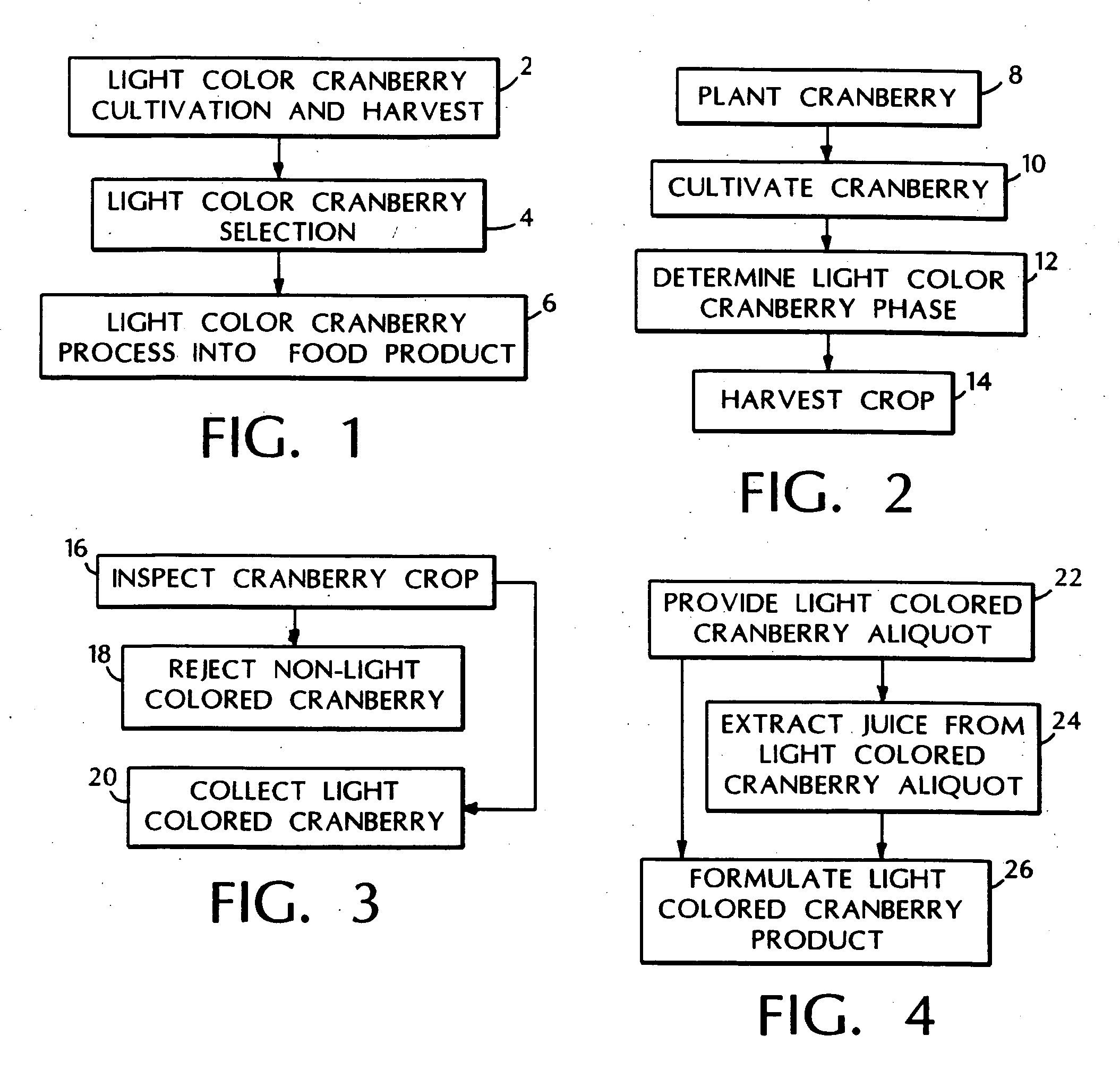Cranberry processes and products
a technology of cranberry and processing equipment, applied in the field of cranberry processing and products, can solve the problems of unpalatable to many consumers, short harvest time requires extensive investment in harvesting equipment, and strong astringent aftertaste, so as to reduce the aftertaste, reduce the effect of quinic acid and modify the flavor
- Summary
- Abstract
- Description
- Claims
- Application Information
AI Technical Summary
Benefits of technology
Problems solved by technology
Method used
Image
Examples
example 1
[0037] Samples of about 1 pound of previously harvested and frozen cranberries were sorted by hand into three visual color categories: red, pink, and white. The samples were pressed by a hydraulic piston press (Carver Instruments, Carver, Inc., Wabash, Inc.) to produce a pure juice. The juices from the sorted samples were analyzed for titratable acidity by titration to pH 8.1 with 0.01 M NaOH, as discussed in Appendix IV which follows the technique in “Method 942.15: Acidity (Titratable) of Fruit Products”, Official Methods of Analysis of the Association of Official Analytical Chemists, vol. two, Fifteenth Edition, Kenneth Helrich, ed., Association of Official Analytical Chemists, Inc., Arlington, Va., p. 918, 1990, the entire contents of which is incorporated herein by reference. The total acidity is expressed using the citric acid factor. Quinic, citric, and malic acids were determined by high pressure liquid chromatography (Coppola et al., “Authenticity of Cranberry Products Incl...
example 2
[0039] Juice products were formulated using red cranberries and light color cranberries. The characteristics of the expressed juice from the berries are provided in Table 2.
TABLE 2juice characteristics% TitratableAcidity% Quinic% Malic% CitricColor*Cranberry(juice)(juice)(juice)(juice)(juice)Light Color3.190.890.651.650.317Red1.95Not Measured1.294(conventionalharvest)
*Optical absorbance at 515 nm of juice diluted to 0.75% soluble solids with pH 2.8 buffer.
[0040] The juice products were formulated to identical titratable acid and solids levels. These levels were around 0.49% titratable acidity (expressed as % citric acid), and 12.2% solids (soluble solids). Formula A was formulated with the light color cranberry juice which was pressed from light color cranberries, and Formulas B, C, and D were formulated with conventionally harvested and pressed red cranberry juice. The juice content was determined based on a standardized solids content of 7.5% soluble solids. The beverage formul...
example 3
[0043] Twenty-five one meter square test sites were established on a bog of the Early Black variety in Rochester, Mass. Treatments with Break-thru (a polyether-polymethylsiloxane copolymer exempt from food tolerance requirement, under 40 CFR 180.1001(c)) (Goldschmidt Chemical Corporation, 914 E. Randolph Road, Hopewell, Va. 23860) (0.1% v / v in tap water) and control (water only) were made in the equivalent of 144 gallons of water per acre with a stainless steel backpack CO2 pressurized backpack sprayer to plots in a completely randomized design, with five replicates per treatment. All plots were surrounded by a 20 centimeter buffer strip. Three treatments received sprays on July 31, and two of these treatments received an additional, identical treatment on either 11 or 15 August.
[0044] The single application of surfactant significantly reduced Early Black color, as measured by total anthocyanin (TAcy) content when berries were harvested (table). Two surfactant treatments further in...
PUM
 Login to View More
Login to View More Abstract
Description
Claims
Application Information
 Login to View More
Login to View More - R&D
- Intellectual Property
- Life Sciences
- Materials
- Tech Scout
- Unparalleled Data Quality
- Higher Quality Content
- 60% Fewer Hallucinations
Browse by: Latest US Patents, China's latest patents, Technical Efficacy Thesaurus, Application Domain, Technology Topic, Popular Technical Reports.
© 2025 PatSnap. All rights reserved.Legal|Privacy policy|Modern Slavery Act Transparency Statement|Sitemap|About US| Contact US: help@patsnap.com


